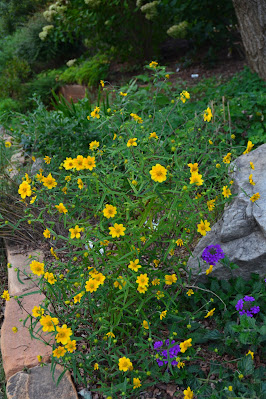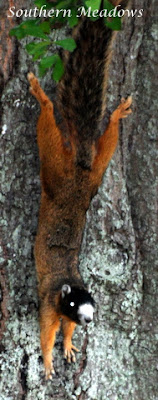September Blooms
Fall flowers are essential for all the insects and birds that feed on nectar. Pollinators need sustenance to prepare for winter or build energy reserves for their journey to their overwintering grounds. In our garden, September sees more pollinators as populations migrate through to their final destination.
It is Garden Blogger Bloom Day, so lets take a look at what is blooming in our Georgia Piedmont, Zone 7b, habitat garden.
In our wildflower garden, which runs along the main road of our subdivision, the white doll's daisy (Baltonia asteroides) blooms are abundant. September is peak flowering time for this native perennial. Despite the small flowers, it makes a bold statement.
The flowers are reminiscent of another native perennial that blooms in early summer, prairie fleabane (Erigeron strigosus).
The passiflora incarnata vine climbs through the white doll's daisy using it as a natural trellis. The result is that many of the fritillary caterpillars use the white doll's daisy stems as a place to form their chrysalis.
One of my favorite features of a wildflower gardens is when plants mingle, creating lovely companions, like this coreopsis and white doll's daisy.
Another great example, is the homestead purple verbena (Verbena canadensis) with another coreopsis spp. The verbena was planted in early summer to fill in some gaps in this bed. In the corner little blue stem (Schizachyrium scoparium) is starting to come into its fall color and will make a beautiful show.
This is the first year for the white solidago (Solidago ptarmicoides) to bloom in our garden. This wildflower is unique in that it has aster-like flowers; hence the common name prairie aster, but the foliage is more goldenrod-like. This perennial tolerates drought and dry soil. The tall stalks have leaned over so the flowers are closer to the mulch, but pollinators don't mind. I could stake it but this way the seeds don't have so far to fall. Maybe next year we'll see a few more plants.
The first of our asters to bloom, New England Aster (Symphyotrichum novae-angliae), is feeding our native bee population.
 |
| bumblebees are especially attracted to the yellow centers |
The rough-stemmed goldenrod (Solidago rugosa) cultivar 'fireworks' has spread prolifically on an area we affectionately call pollinator hill. Partnered with Helianthus hirsutus it creates a lush vegetation of yellow flowers in the fall.
Another beauty is this stone mountain daisy, a reseeding native annual. Every year it is a surprise to see where it will show up in our garden.
Cutleaf coneflower (Rudbeckia laciniata) is in its second year in our garden. It needs some better companions to really make it proud in the landscape. Thus far, it hasn't been to robust. It is a long blooming perennial providing nectar source for bees, butterflies, wasps and other tiny pollinating insects.
 |
| sweet red-banded hairstreak resting on the petals |
Want to see more fall blooming gardens? Jump over the May Dreams Gardens for a list of bloggers who are sharing their inspiration. Happy Bloom Day!











.png)